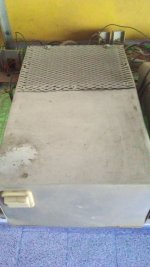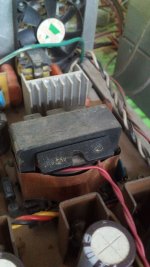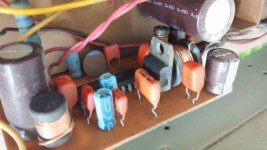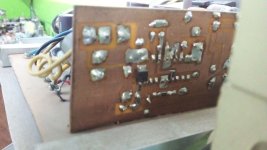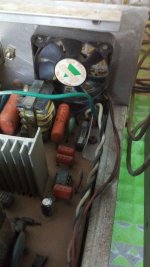As an interesting aside, HP/Agilent (don't remember the exact age of the instrument) did an SMPS that switched at over 1MHz. It came out of one of their RF spectrum or network analyzers, mid '90s I'd guess. They published some details on the technology at the time. The PCB didn't look like a power supply on first glimpse.
Yessir, that is what I think as well.I guess those supplies were run on the ragged edge. If the TV will pull 400W when operating, the manufacturer throws in a 420W ps.
It’s even worse for audio, where you might draw 400 watts of long term average with unclipped music and the manufacturer throws in a 420 watt supply. (This would be for a large live sound amp, rated at maybe 3-5 kW. This is EXACTLY the use case of the Behringer iNuke). Scale everything back by a factor of 10 for a typical home stereo/subwoofer. Rarely do you see supplies capable of more than 20 to 50 real watts in those stupid powered subwoofers. Then I get asked to “fix” it. I tell ‘em to scrap it and try to kluge a replacement amp.
What I see around HERE is people who build class A and tube amps singing praises for SMPSs. When the current draw is CONSTANT of course you will have less trouble with it. Especially if you do over size it by enough to matter. And when you buy a supply from Digikey ($$$) or even E-bay it’s still likely to be better than what some bean counter says has to go into that piece of consumer gear you’re looking at buying.
What I see around HERE is people who build class A and tube amps singing praises for SMPSs. When the current draw is CONSTANT of course you will have less trouble with it. Especially if you do over size it by enough to matter. And when you buy a supply from Digikey ($$$) or even E-bay it’s still likely to be better than what some bean counter says has to go into that piece of consumer gear you’re looking at buying.
How about all of those 12V car amps that were MOSFET class AB and still up to 1000W in the 90's? All of them used SMPS (boost converters are a type of SMPS, no?) since I don't know any speakers that are rated in milliohms 😛
The do use some primitive version of smps - and more often than not miserably fail.How about all of those 12V car amps that were MOSFET class AB and still up to 1000W in the 90's? All of them used SMPS (boost converters are a type of SMPS, no?) since I don't know any speakers that are rated in milliohms 😛
Car audio DC/DC converters don’t have to deal with 390 volt mains. And most of them are NOT very efficient. 80% is common. You can make one pretty sloppy with 1 or 2 microseconds rise and fall times running at 12 volts and 50 or so peak amps and not have it blow up in your face. Stepping down 390 volt mains you have to be a lot more careful with it or overloads or even just repeated high stress can be disastrous. Even then, those car amps are not the last word in reliability either.
Also consider that a true 1000w is 1000w. Do the math. Sure a car amp can use a DC/DC converter to run a 1000w audio amp on 12 volts. But consider the current required at 12volts! Not gonna happen.
What do you mean? 200 ampere alternators are common - this is 2400 watts @12V but the alternator is putting out a higher voltage than that.
83 to 133 Amps at full roar. My truck had an 80A alternator and sucked over 200 Amps for many seconds to start in sub-sub-freezing weather. Audio, like starting, is not a steady load. Even the worst BOOM-da-BOOM bass-beasts are off-peak half the time. And my truck was a plow-truck; if I was seriously making an annoyance wagon I would have much bigger dynamo and battery plus Farad caps and 4-Ought wires or busbars for peaks.run a 1000w audio amp on 12 volts. But consider the current required at 12volts! Not gonna happen.
The attitude can't be denied.
Sony Xplod: "Disturb The Peace"
Pioneer: "Disturb, Defy, Disrupt, Ignite".
JBL: "Either we love BASS or hate your neighbors."
JL Audio: "Be Very Afraid."
Kicker: "You deserve a beating...Kicker's loudest, meanest subwoofer ever!"
Concept: "When TOO loud...is just right!"
Lightning Audio: "Sonic submission."
Boss Audio System: "Turn it down? I don't think so."
Cerwin-Vega Mobile Audio: "Shake the living, wake the dead."
Crossfire: "We're louder...Deal with it!"
Earthquake Sound: "The Meanest, Loudest, Most Powerful, Mother F--- Amplifiers Money Can Buy!"
Viper Audio: "Cold Blooded. Violent Fury and Multi-Channel Mayhem."
Orion High Performance Car Audio: "Be Loud. Be Obnoxious."
The point is that a 1000w audio amplifier in a car is utterly ridiculous! Yes I get the peak vs average loudness but a 100 watt amplifier will more than satisfy that.
“Nobody needs loud bass.”
That doesn’t change the fact some people want it. And when people are crammed into apartments the car may be the only place left to have loud music.
That doesn’t change the fact some people want it. And when people are crammed into apartments the car may be the only place left to have loud music.
My samsung led display smps broke the other day . I tried to power up the samsung display with a 25va 14v transformer and its blink and shut down again and again . And it came with 14v 14w smps. Wonder y
20Hz is not sound. We can feel it bit not hear it.Not at 20 Hz...
Your display has a fault, maybe, and killed your first power supply and is now working on the second one.My samsung led display smps broke the other day . I tried to power up the samsung display with a 25va 14v transformer and its blink and shut down again and again . And it came with 14v 14w smps. Wonder y
Well?
Will it (The SMPS or the mighty fine, classic linear) make you play more music on your music/ home cinema system?
(If it will not: it simpy
sucks a gigantic retards complete and entire a*s. Quite Possibly For A very long time.)
❄️❄️🎄🎸🎅🏻🎷🎄❄️❄️
Will it (The SMPS or the mighty fine, classic linear) make you play more music on your music/ home cinema system?
(If it will not: it simpy
sucks a gigantic retards complete and entire a*s. Quite Possibly For A very long time.)
❄️❄️🎄🎸🎅🏻🎷🎄❄️❄️
SMPS if carefully selected are very good performers.
There are mainly two kinds of SMPS: those derived from the Buck and those from Boost.
Buck derived (Buck, Forward (single and double MOSFET), Half and Full Bridge) are the worst choice. This is because they need an output inductor like those for choke input filter at 50/60Hz. This choke/inductor toguether output filter capacitor make a double pole filter. Viewed from the PWM control chip this is a low frequency pass filter with an inherent time delay to mantain the output voltage. So they are very utile for steady loads like computers, hard disks, and the like. But they are slow correction devices for load regulation.
ITOH the derived from boost topology and mainly the Fly Back (single and double MOSFET) are inherently higher speed because they use a much smaller inductor in the primary side that with current mode SMPS (UC384x and similar) completely dissapear from the transfer equation, remaining only the ouput caps. As they usualy have higher RF ripple, usually a small pi filter is used but its time constant and time delay are noticeably lower than buck, making them quicklier response than those. The Boost deriver are thus, clearly, the best option.
I made my SMPS UC3842 & STP7N60 running at 45KHz based several years ago and the regulation from no audio to full power is almost no clearly measurable. It can be found a high degree of "rectified audio" at the return of the control loop TL431 & PC817 at normal listening levels.
This data I learned from the two books I have for SMPS design: Marty Brown "Practical Switching Power Supply Design" and Abraham Pressman "Switching Power Supply Design" and confirmed by my own.
There are mainly two kinds of SMPS: those derived from the Buck and those from Boost.
Buck derived (Buck, Forward (single and double MOSFET), Half and Full Bridge) are the worst choice. This is because they need an output inductor like those for choke input filter at 50/60Hz. This choke/inductor toguether output filter capacitor make a double pole filter. Viewed from the PWM control chip this is a low frequency pass filter with an inherent time delay to mantain the output voltage. So they are very utile for steady loads like computers, hard disks, and the like. But they are slow correction devices for load regulation.
ITOH the derived from boost topology and mainly the Fly Back (single and double MOSFET) are inherently higher speed because they use a much smaller inductor in the primary side that with current mode SMPS (UC384x and similar) completely dissapear from the transfer equation, remaining only the ouput caps. As they usualy have higher RF ripple, usually a small pi filter is used but its time constant and time delay are noticeably lower than buck, making them quicklier response than those. The Boost deriver are thus, clearly, the best option.
I made my SMPS UC3842 & STP7N60 running at 45KHz based several years ago and the regulation from no audio to full power is almost no clearly measurable. It can be found a high degree of "rectified audio" at the return of the control loop TL431 & PC817 at normal listening levels.
This data I learned from the two books I have for SMPS design: Marty Brown "Practical Switching Power Supply Design" and Abraham Pressman "Switching Power Supply Design" and confirmed by my own.
I want to add that my SMPS gives 3 direct outputs plus one more post-regulated. From the Ringing Choke I obtain plus and minus 14V for TDA2006's (3 of them) and plus 12V. Post regulator around L4974 (The vertical add on vissible in pic #6) downconverts those 12V into 5.1V. Both are for feed old PC CDROM reader, now out of use. At pic#4 it can be seen a single turm around center tongue to synchronize L4974 to main switching frequency to reduce RF polution. Outside the SMPS itself there are LM7805 and LM7905 to reduce and isolate opamps for tone and matrix control and HCF4051 (2) for input select, and from 12V the AM/FM tuner (TDA7211 and TDA1220B) and TDA2003 (3) for driving tweeters independently from woofers.
The level of QRM radiated is really low and no disturb AM reception in the same set.
The level of QRM radiated is really low and no disturb AM reception in the same set.
- Home
- Amplifiers
- Power Supplies
- SMPS in audio
